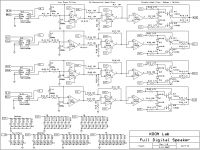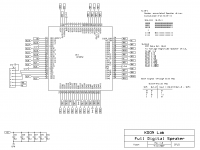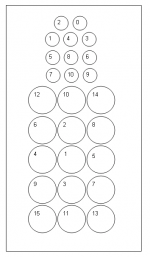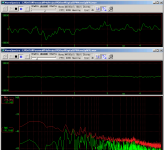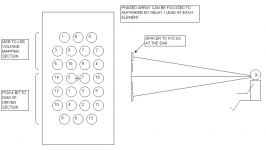I made some DAC by
(1) Voltage magnitude and summing. easy, common R-2R DAC.
(2) Analog magnitude and summing. DIY PowerDAC project.
But there are one more way.
(3) Sound pressure summing.
Case A: you have 32768 speaker element. PCM signal is converted to "numbers" of driven elements, and +/- are converted to drive voltage.
Case B: you have 15 speaker element. Element for MSB is driven by +/-Reference V, and Elements for LSB is driven by +/-(1/32768)Reference V. (below 0.03mV)
Both cases are unrealistic. lets merge both..
15 Elements: driven by D14 to D11, "numbers" driven by upper 4 bits. (15 driven to 0 driven)
11 elements: driven by D10 to D0, "voltage magnitude" driven. Reference Voltage to 1/2048 voltage.
(D15 represents + / - drive voltage)
There are 26 speaker elements per channel, so I need 26 small amplifier per channel.
What will happen when 26 2-inch full range speakers are driven by PCM digital signal?
I completely can not imagine frequency response.
This project will require at least...
56 OpAmps
616 Registers
784 Capacitors
72 TRs
112 Diodes
56 analog switch
Kind of crazy project again
(Full Digital Speaker, with multiple voice coil for each bits, were investigated by some university / manufacturer )
(1) Voltage magnitude and summing. easy, common R-2R DAC.
(2) Analog magnitude and summing. DIY PowerDAC project.
But there are one more way.
(3) Sound pressure summing.
Case A: you have 32768 speaker element. PCM signal is converted to "numbers" of driven elements, and +/- are converted to drive voltage.
Case B: you have 15 speaker element. Element for MSB is driven by +/-Reference V, and Elements for LSB is driven by +/-(1/32768)Reference V. (below 0.03mV)
Both cases are unrealistic. lets merge both..
15 Elements: driven by D14 to D11, "numbers" driven by upper 4 bits. (15 driven to 0 driven)
11 elements: driven by D10 to D0, "voltage magnitude" driven. Reference Voltage to 1/2048 voltage.
(D15 represents + / - drive voltage)
There are 26 speaker elements per channel, so I need 26 small amplifier per channel.
What will happen when 26 2-inch full range speakers are driven by PCM digital signal?
I completely can not imagine frequency response.
This project will require at least...
56 OpAmps
616 Registers
784 Capacitors
72 TRs
112 Diodes
56 analog switch
Kind of crazy project again
(Full Digital Speaker, with multiple voice coil for each bits, were investigated by some university / manufacturer )
Attachments
This has to be one of the most imaginative things I've ever read on this site.
What sort of physical array have you in mind for these drivers?
I found this after a bit of googling:
http://www.aes.org/journal/toc/AES-Oct2002TOC.html
http://www.wcl.ee.upatras.gr/audiogroup/Publications/Full Papers/Digital Loudspeaker Arrays.pdf
http://www.aes.org/e-lib/browse.cfm?elib=12619
These guys seem closest to what you're proposing:
http://scitation.aip.org/getabs/ser...00114000001000174000001&idtype=cvips&gifs=yes
What sort of physical array have you in mind for these drivers?
I found this after a bit of googling:
http://www.aes.org/journal/toc/AES-Oct2002TOC.html
http://www.wcl.ee.upatras.gr/audiogroup/Publications/Full Papers/Digital Loudspeaker Arrays.pdf
http://www.aes.org/e-lib/browse.cfm?elib=12619
These guys seem closest to what you're proposing:
http://scitation.aip.org/getabs/ser...00114000001000174000001&idtype=cvips&gifs=yes
I remember when I was still in collage, my professor once have similar idea.
Instead of R2R, he tried the ladder DAC with 16 element speaker array. Sd of each element range from 1S, 2S, 4S.... 16384S.
But he failed to get it work.
I don't know the reason of his failure. But I wondered the frequency spectrum of individual bit would look like.
For example 16bit NOS data, I guess it'll span very wide
Instead of R2R, he tried the ladder DAC with 16 element speaker array. Sd of each element range from 1S, 2S, 4S.... 16384S.
But he failed to get it work.
I don't know the reason of his failure. But I wondered the frequency spectrum of individual bit would look like.
For example 16bit NOS data, I guess it'll span very wide
There was a british company named 1ltd that tried to do what you are doing a number of years ago.
The technology is presently used in some "one speaker surround sound projectors" from Yamaha !
Aura sound maskes some small full range drivers - take a look at madisounds page, they seem to stock them. They look like the Yamaha drivers.
http://www.madisound.com/aurasound.html
The technology is presently used in some "one speaker surround sound projectors" from Yamaha !
Aura sound maskes some small full range drivers - take a look at madisounds page, they seem to stock them. They look like the Yamaha drivers.
http://www.madisound.com/aurasound.html
Ideally, you would want all these drivers to act as a point source, right?
So why not try a pattern where the small drivers are placed in the empty space between the large drivers? I can't draw a picture at the moment but imagine 5 columns of large drivers: 2 on the left, then 3, then 5 in the middle, then 3, then 2 on the right. And in between each of the large drivers is a small driver.
So why not try a pattern where the small drivers are placed in the empty space between the large drivers? I can't draw a picture at the moment but imagine 5 columns of large drivers: 2 on the left, then 3, then 5 in the middle, then 3, then 2 on the right. And in between each of the large drivers is a small driver.
A cool idea, really love it, but there is one big problem.
The nonlinearity of air.
I should know, I started work on this concept about 17 years ago. ( I was not the first). I had a few email conversations about 10 years ago with the guy in England who got venture capital invested in the same thing. He had been written up in some EE journals. Our ideas were very similar, he was at the same crude prototype stage I was at the time. We both used off the shelf ultrasonic transducers.
The problem is trying to get all those elements to generate a waveform in the air that is anything like the input signal. It just doesn't work. Heavy DSP is needed to make it sound right.
Don't know whatever happened to the Brit effort. It may well be in the Yamaha unit, but from what I've read the Yamaha is a little different.
As for me, I never got anywhere much with it. But it did lead me to "Digital" amplification, for which I'm grateful.
The nonlinearity of air.
I should know, I started work on this concept about 17 years ago. ( I was not the first). I had a few email conversations about 10 years ago with the guy in England who got venture capital invested in the same thing. He had been written up in some EE journals. Our ideas were very similar, he was at the same crude prototype stage I was at the time. We both used off the shelf ultrasonic transducers.
The problem is trying to get all those elements to generate a waveform in the air that is anything like the input signal. It just doesn't work. Heavy DSP is needed to make it sound right.
Don't know whatever happened to the Brit effort. It may well be in the Yamaha unit, but from what I've read the Yamaha is a little different.
As for me, I never got anywhere much with it. But it did lead me to "Digital" amplification, for which I'm grateful.
Thank you for informations.
I'm not so pessimistic. Please anticipate my Kamikaze attack.
Attached shows 2 wav form, created from "cum on feel the noize" by Quiet Riot. Upper one shows 4-bit, you can see steps. lower is wave form by D10 to D0.
now simulating and I feel Listening point focusing will be important. (same as written in PDF)
I'm not so pessimistic. Please anticipate my Kamikaze attack.
Attached shows 2 wav form, created from "cum on feel the noize" by Quiet Riot. Upper one shows 4-bit, you can see steps. lower is wave form by D10 to D0.
now simulating and I feel Listening point focusing will be important. (same as written in PDF)
Attachments
At principle, yes.
when sound is represented by
is represented by
y=G[f(t)],
f(t): original sound wave, represented by FFT
G[]: Speaker responce function
This speaker system's output will be
y' = Sigma[Gk[Hk[f(t - Tk)]]
where
k: Speaker element, 1 to 26
Gk[]: Speaker transient response function.
Hk[]: bit fetch function.
Tk: each speaker's time delay from center point.
When
(1) all Gk[] = G[], all speaker transient is same
(2) Sigma[Hk[]] = 1, this is no problem.
(3) all Tk = 0, all driver has same distance from ear,
y' = y.
I'm not sure about (1)'s importance.
when sound
y=G[f(t)],
f(t): original sound wave, represented by FFT
G[]: Speaker responce function
This speaker system's output will be
y' = Sigma[Gk[Hk[f(t - Tk)]]
where
k: Speaker element, 1 to 26
Gk[]: Speaker transient response function.
Hk[]: bit fetch function.
Tk: each speaker's time delay from center point.
When
(1) all Gk[] = G[], all speaker transient is same
(2) Sigma[Hk[]] = 1, this is no problem.
(3) all Tk = 0, all driver has same distance from ear,
y' = y.
I'm not sure about (1)'s importance.
They've been working on digital loudspeakers for a while here in Greece. Check this.
Here is what bothers me. I am thinking of a simple sinewave input waveform. The output to each speaker element is a waveform of the same fundamental frequency as the input frequency. If the different drivers each produce a different phase error at this frequency, then there will be some cancellation. There will be more cancellation due to off-axis effects. So I think the only way this can work is if the drivers are all identical, and you are only listening on-axis.
Today I ordered 60 lot of 2 inch driver
>fdeck
Yes, now I'm thinking how to adjust phase by mm order to listening position.
I revise myself. To think DLA (digital loudspeaker array), it's btter to think about inpulse than sinewave. more simpler.
And bit-per-driver section works in -30dB order, so importance of identical is reduced -30dB. (Gk difference effect goes more smaller, to LSB)
>fdeck
Yes, now I'm thinking how to adjust phase by mm order to listening position.
I revise myself. To think DLA (digital loudspeaker array), it's btter to think about inpulse than sinewave. more simpler.
And bit-per-driver section works in -30dB order, so importance of identical is reduced -30dB. (Gk difference effect goes more smaller, to LSB)
This is not a normal speaker anymore, it's a Phased Array Rader....
Phased array can focus anywhere by applying delay / advance for each element. (physically / electrically)
I will make it mechanically to focus on horizontal, 6 ft distance.
(just a spacer for each element to make distance equal)
For auto focusing I need these 2. too much now
(a) 3-dimensional position finder
at least 5 element mic array to analyze hand clapping
(b) DSP to apply delay for each elements
to focus on position found at (a)
Phased array can focus anywhere by applying delay / advance for each element. (physically / electrically)
I will make it mechanically to focus on horizontal, 6 ft distance.
(just a spacer for each element to make distance equal)
For auto focusing I need these 2. too much now
(a) 3-dimensional position finder
at least 5 element mic array to analyze hand clapping
(b) DSP to apply delay for each elements
to focus on position found at (a)
Attachments
Could you not get the same effect by arranging them in a circular fashion? (Off axis response might be nicer too. I think that's what the Greeks did).
just a spacer for each element to make distance equal
"Greeks" means Fotios Kontomichos, Nicolas – Alexander Tatlas, and John Mourjopoulos?
They are using tiled array. I have pdf...
Circular fashion goes too large, and distance of diagonal pair will be about 20 inch > twice as arrayed. especially horizontal positioning, it will have too tenderness.
They are using tiled array. I have pdf...
Circular fashion goes too large, and distance of diagonal pair will be about 20 inch > twice as arrayed. especially horizontal positioning, it will have too tenderness.
In the usual listening environment we hear a substantial amount of off-axis sound reflected by walls, floor and ceiling. A good-sounding speaker can exhibit wide or narrow directivity, but it must produce good off-axis sound. This speaker DAC idea is not practical because it produces terrible off-axis output.
- Status
- This old topic is closed. If you want to reopen this topic, contact a moderator using the "Report Post" button.
- Home
- Amplifiers
- Class D
- Full Digital Speaker
